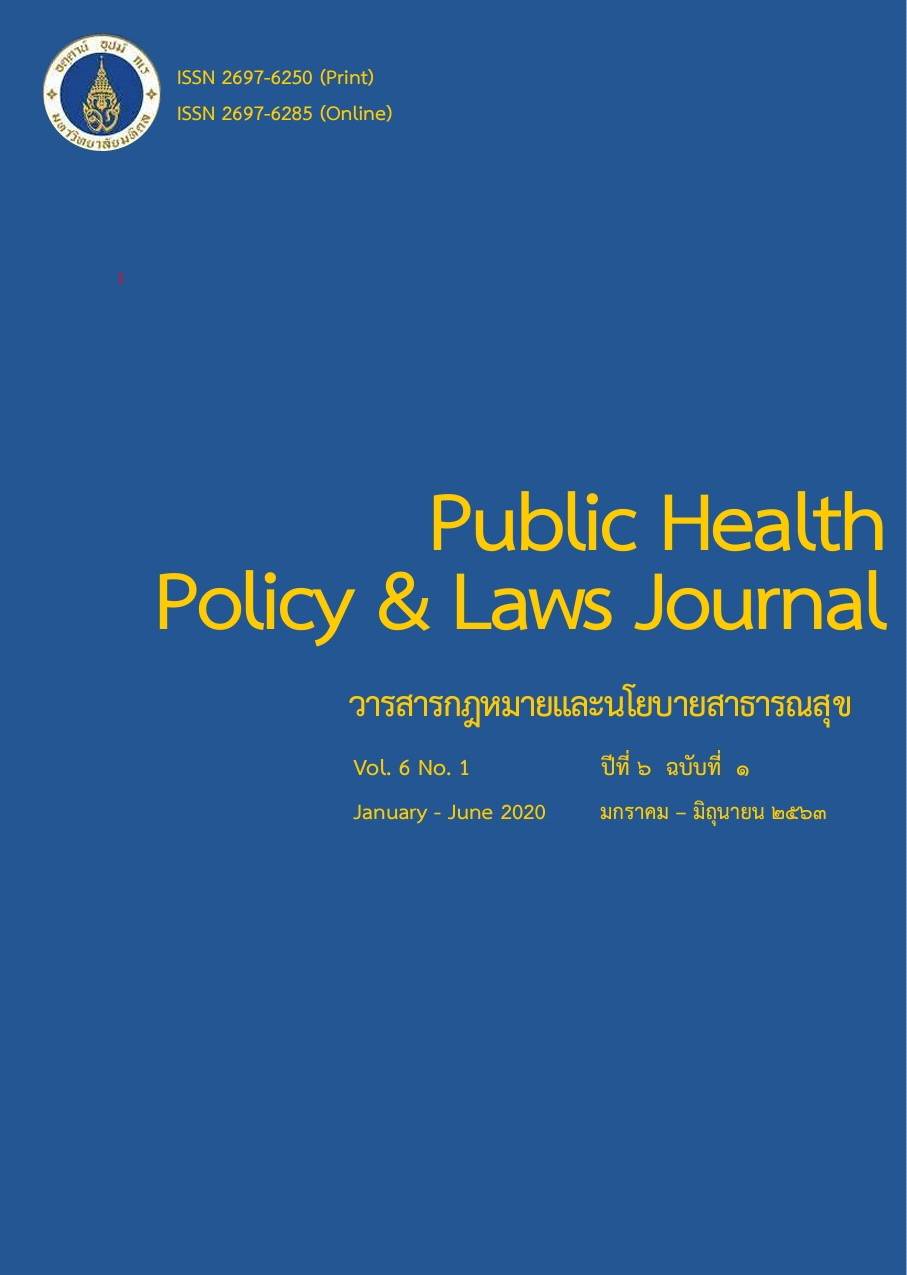Smoking behavior among students in the school of Engineering, a University in the Northern Region of Thailand
Keywords:
smoking behavior / students / Faculty of EngineeringAbstract
This research was a cross-sectional study, aimed to identify factors that are associated with the smoking behavior of students in the Faculty of Engineering, 4th year of a university in the Northern Region, Thailand. A sample size was students 160. Data were analyzed by using percentage, mean, and standard deviation, Chi-square statistics and Fisher's Exact test.
The study indicated that most of the sample were male (73.7%), 22 years old (63.7%) and (100%) of students in grade 4. Stayed the dorm outside from University was (93.7%), and dorm inside from the University (20.6%). Smoking behavior (26.9%), smoking 1-5 cigarettes per day (17.5%), a high level of knowledge and attitudes (73.1% and 56.2% respectively) and smoking learning and habits were at low level (57.5% and 63.1% respectively). The correlation analysis showed that underlying, smoking history, the number of smoking cigarettes per day, knowledge, attitudes, and learning were correlated with smoking behavior in a statistically significant (p-value = 0.001). Besides, gender, age, and money received from parent's weekly average were not correlated with smoking behavior.
In conclusion, smoking behavior the fourth-year students at the Faculty of Engineering, A University of Northern Region was associated with persistent smoking history, volume of smoke, knowledge, attitudes, and learning. Therefore, institutions should give priority to modify their smoking habits. As well as public health agencies are required to play a role in the campaign to reduce the behavior of smokers to minimize higher education institutions.
References
ประภาพร ดองโพธิ์ และนรลักษณ์ เอื้อกิจ. (2561). ปัจจัยทำนายการเลิกสูบบุหรี่ของผู้ป่วยโรคหลอดเลือดหัวใจ โรงพยาบาลธรรมศาสตร์เฉลิมพระเกียรติ.วารสารธรรมศาสตร์เวชสาร, 18 (1), 40-50.
ปฏิภาณ วิปัดทุม และคณะ. (2561). การศึกษาปัจจัยที่มีความสัมพันธ์กับพฤติกรรมการสูบบุหรี่ของวัยทำงานในจังหวัดพะเยา. วารสารสาธารณสุขน่าน, 1(2), 63-74.
ปริวัตร ปาโส และคณะ. (2560). พฤติกรรมการสูบบุหรี่ของนักกีฬามหาวิทยาลัยราชภัฏร้อยเอ็ด ปัตตานี, วารสารมหาวิทยาลัยราชภัฏร้อยเอ็ด, 11(1), 113-119.
วารีพร ชูศรี จุฑามาศ พรหมมนตรี และบุตรี บุญโรจน์พงศ์.(2561)การเข้าถึงยาสูบ การรับรู้และการปฏบิ ตัิตามกฎหมายควบคุมผลิตภัณฑ์ยาสบูของนักเรียน นักศึกษา ประชาชน และผู้จำหน่ายบุหรี่รอบเขตมหาวิทยาลัยหาดใหญ่.วารสารกฎหมายสุขภาพและสาธารณสุข, 4(2) พฤษภาคม–สิงหาคม 2561.หน้า 179-193.
ศศิธร ชิดนายี และวราภรณ์ ยศทวี. (2561). ปัจจัยที่มีความสัมพันธ์กับพฤติกรรมการสูบบุหรี่ของวัยรุ่นจังหวัดอุตรดิตถ์. วารสารวิทยาลัยพยาบาลบรมราชชนนี อุตรดิตถ์, 10 (1), 83-93.
ศูนย์วิจัยและจัดการความรู้เพื่อการควบคุมยาสูบ.(2562).ประกาศปฏิญญา "สร้างบ้านปลอดบุหรี่" ลดป่วยตายทั้งที่ไม่ได้สูบเอง.การประชุมวิชาการบุหรี่กับสุขภาพแห่งชาติ ครั้งที่ 18, available from https://www.trc.or.th/th/ข่าวสารข่าวสารบุหรี่/290-ประกาศปฏิญญา-สร้างบ้านปลอดบุหรี่-ลดป่วยตายทั้งที่ไม่ได้สูบเอง.html
สุทธนู ศรีไสย์. (2551). สถิติประยุกต์สำหรับงานวิจัยทางสังคมศาสตร์. กรุงเทพฯ: คณะครุศาสตร์. พิมพ์ครั้งที่ 3. หน้า 132-133.
อัศวศิริ ลาปีอี และคณะ.(2560).ความสัมพันธระหวางการรับรูและอิทธิพลจากสื่อกับการปรับเปลี่ยนพฤติกรรมการสูบบุหรี่ของเยาวชนในระดับอาชีวศึกษาพื้นที่สามจังหวัดชายแดนภาคใต้.วารสารกฎหมายสุขภาพและสาธารณสุข, 3 (3) กันยายน – ธันวาคม 2560.หน้า 321-340
Downloads
Published
How to Cite
Issue
Section
License
Disclaimer and Copyright Notice
The content and information presented in articles published in the Journal of Law and Public Health Policy represent the opinions and sole responsibility of the respective authors. The editorial board does not necessarily agree with or assume any responsibility for the views expressed.
All articles, data, content, images, and other materials published in the Journal of Law and Public Health Policy are the intellectual property of the journal. Any individual or organization wishing to reproduce, distribute, or otherwise use the entirety or any part of such materials must provide proper citation.





